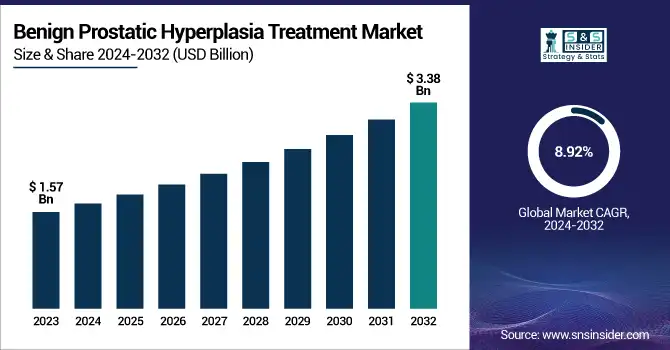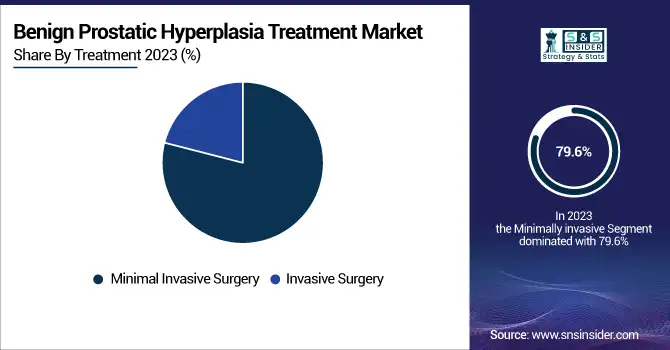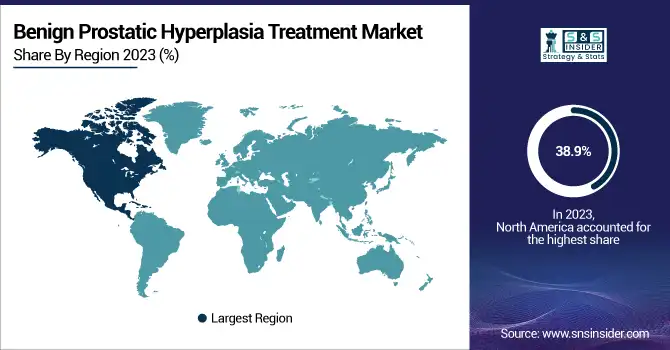Benign Prostatic Hyperplasia Treatment Market Size Analysis:
The Benign Prostatic Hyperplasia Treatment Market Size was valued at USD 1.57 billion in 2023 and is expected to reach USD 3.38 billion by 2032 and grow at a CAGR of 8.92% over the forecast period 2024-2032. This report is a discussion on the growing incidence and prevalence of BPH, with more aging patients looking for available treatment alternatives. This research delves into treatment adoption and prescription rates by region, evaluating differences in surgical and minimally invasive procedure volume. The research also delves into healthcare expenditures on the treatment of BPH, measuring the contributions from government, commercial, private, and out-of-pocket payers. Moreover, the study examines patient demographics and trends in treatment preferences with a focus on the increasing need for non-invasive treatments, new technologies, and treatment solution innovation. The role of lifestyle modifications and preventive care in shaping the BPH market is examined, as well as economic and reimbursement trends driving the affordability and accessibility of treatments.

To Get more information on Benign Prostatic Hyperplasia Treatment Market - Request Free Sample Report
Benign Prostatic Hyperplasia Treatment Market Dynamics
Drivers
-
Increasing Prevalence of BPH and Advancements in Treatment Technologies
Increasing incidence of benign prostatic hyperplasia (BPH), especially among the geriatric population, is a major driving force in the market. Reports suggest that more than 50% of men aged 50 and over and almost 90% of men aged 80 and older have symptoms related to BPH, thus heightening the demand for efficient therapies. Increasing recognition and accessibility of minimal invasive interventions further fueled the market growth. Devices like UroLift, Rezūm, and GreenLight Laser Therapy are gaining popularity with decreased recovery times, less complexity in procedures, and the feasibility of outpatient treatments. Increased healthcare spending and insurance coverage for BPH treatment systems and procedures have also increased patient access to leading-edge treatments. Pharmaceutical innovations, such as alpha-blockers and 5-alpha reductase inhibitors, continue to provide non-surgical treatment options, further broadening the total market potential. Players like Boston Scientific and PROCEPT BioRobotics are also leading innovation in the form of robot-assisted surgical equipment like AquaBeam Robotic Therapy, further increasing demand in the market. In addition, lifestyle factors like obesity, diabetes, and hypertension that drive BPH occurrence are also on the rise, compelling demand for effective and sustained treatment solutions. The increasing popularity of minimally invasive treatments should continue to support the market in the positive direction over the coming years.
Restraints
-
High Treatment Costs and Limited Accessibility in Emerging Markets
Although considerable progress has been made, the exorbitant price of BPH treatment devices and procedures continues to be a significant deterrent. Minimally invasive treatments like robot-assisted surgeries and laser treatments tend to involve costly medical equipment and skilled personnel, thereby increasing the cost of treatment. For example, robotic-assisted prostatectomy procedures can run as high as USD 15,000 per procedure, which makes them unaffordable for patients without full insurance coverage. Moreover, gaps in insurance reimbursement and restricted coverage for newer, more advanced BPH treatments are financial burdens for most patients, especially in middle- and low-income areas. Access to skilled urologists and specialized healthcare facilities also differs greatly by region, limiting access to advanced BPH treatments. In addition, in developing nations, conventional treatments like alpha-blockers and 5-alpha reductase inhibitors are still the first line of treatment because they are less expensive, thus slowing down the uptake of sophisticated medical devices.
Opportunities
-
Rising Demand for Minimally Invasive Treatments and AI Integration
The increasing demand for minimally invasive treatments of BPH is a strong market opportunity. With more than 60% of men having moderate to severe BPH symptoms that need to be treated, the market is growing for less invasive and non-surgical interventions. Procedures like Rezūm Water Vapor Therapy, UroLift System, and Aquablation Therapy are picking up popularity with their low risk, short recovery time, and good symptom relief. In addition, innovations in robotic-assisted and artificial intelligence-based surgical interventions are revolutionizing the market. Artificial intelligence and machine learning technologies in the diagnosis and treatment planning of BPH can advance accuracy, patient results, and reduce risks of procedures. Convergence with telemedicine and digital health platforms is also creating new growth opportunities for urologists to provide remote consultations, track post-procedure recovery, and improve patient care. Additionally, increasing interest in biodegradable implants, drug-device combination products, and future catheter systems presents encouraging opportunities for innovation. A number of market participants, such as PROCEPT BioRobotics and Teleflex, are investing heavily in sophisticated robotic technology to enhance surgery efficiency and the rate of patient recovery. With increasing investment in digital and minimally invasive medical technologies by healthcare systems, the BPH treatment market is likely to see a great deal of technological development and implementation in the near future.
Challenges
-
Risk of Post-Treatment Complications and Patient Hesitation Toward Surgery
One of the greatest challenges in the BPH treatment market is post-treatment complication risk and patient resistance to surgical procedures. Although minimally invasive procedures have their advantages, a high percentage of patients still develop side effects like urinary incontinence, erectile dysfunction, retrograde ejaculation, and infection risks after treatment. Research indicates that almost 15-20% of men treated with TURP suffer from retrograde ejaculation, impacting patient satisfaction and treatment acceptance. Also, most patients wait until they are in extreme pain before visiting a doctor for treatment because of fear of undergoing surgery, unawareness of new, less painful procedures, and fear of long-term side effects. The psychologic barrier with prostate interventions, especially among elderly men, limits further market growth.
Benign Prostatic Hyperplasia Treatment Market Segmentation Analysis
By Treatment
Minimally invasive surgical procedures (MIS) were the leading method of BPH treatment in 2023 with a market share of 79.6%. MIS is influenced by its proven capability to cure symptoms with short hospital stays, low postoperative complications, and quick recovery time as compared to open procedures. Technologies like UroLift, Rezūm, and laser therapies (HoLEP, GreenLight Laser Therapy) have seen increased popularity because they enable sexual function preservation and lower the threat of serious bleeding. The growing preference of patients toward outpatient procedures, along with technological innovation in surgical devices, has further consolidated dominance in this segment. Higher awareness about non-invasive options among patients as well as healthcare professionals has also fueled adoption. The segment is also expected to expand at the highest rate owing to ongoing technological improvements, increased procedural success rates, and better reimbursement conditions. With healthcare providers focusing on cost-effective and efficient treatment, minimally invasive procedures are likely to substitute conventional surgical techniques at a growing rate.

By Procedure
Transurethral Resection of the Prostate (TURP) commanded the maximum market share of 29.3% during 2023, its position as the gold standard for the treatment of moderate to severe BPH. TURP is largely known for its success rate, long-term symptom improvement, and well-established safety profile, appealing to urologists and patients alike. TURP consists of the removal of excess prostate tissue with an endoscopic resectoscope, successfully relieving urinary obstruction. In spite of the emergence of minimally invasive options, TURP continues to dominate because of its universal availability, insurance reimbursement, and robust clinical record.
The Robot-Assisted Laparoscopic Prostatectomy (RASP) category is forecasted to exhibit the highest growth rate, bolstered by its superior accuracy, least invasive, and faster recuperation periods. With more and more hospitals undertaking investment in robot-based surgery technology, RASP is becoming an encouraging substitute to the conventional TURP procedure in developed regions where healthcare costs are higher.
By Product
The resectoscopes segment led the market for BPH treatment in 2023 with a 25.7% market share. Resectoscopes are vital surgical devices utilized in TURP, the most common procedure for treating BPH. The segment's dominance is based on TURP's historical clinical acceptance, excellent treatment success rate, and widespread hospital use across the globe. Resectoscopes have developed immensely, from enhanced visualization capacities, bipolar energy-based configurations, and improved ergonomics that have boosted surgery efficiency and safety for the patient.
The laser segment of urology is the most rapidly growing one, fueled by growing use of laser-based procedures like Holmium Laser Enucleation of the Prostate (HoLEP) and GreenLight Laser Therapy. These treatments provide significant benefits like less bleeding, quicker recovery times, and lower postoperative complications, thus being more popular compared to conventional TURP. Moreover, technological advancements in laser technology, increasing reimbursement coverage, and increasing patient demand for non-invasive treatments are driving the high growth of this segment. With continuous developments in precision-guided laser therapies, the urology laser market is likely to experience continued growth in the future.
By End-use
The hospitals segment occupied the highest market share of 69.3% in 2023, and it remains the main treatment facility for BPH procedures. Hospitals are sought after because they have specialized urologists, sophisticated medical equipment, and full-fledged patient care facilities. The majority of surgical and minimally invasive BPH therapies, including TURP, laser treatments, and robotic surgeries, are done in hospitals, which provides a consistent demand for hospital-based urology facilities.
Hospitals are also the most rapidly expanding segment, boosted by growing adoption of minimally invasive surgical alternatives, increasing patient admissions for treatment of BPH, and advancements in technology for hospital-based urological procedures. The merging of robotic-assisted procedures, telemedicine consultations, and outpatient surgical programs is also reinforcing hospital-based BPH treatment facilities. With an increasing number of hospitals embracing advanced surgical robots, precision-guided laser treatments, and AI-powered diagnostic tools, the segment is poised to experience steady growth, further cementing its leadership in the market for BPH treatment.
Benign Prostatic Hyperplasia Treatment Market Regional Insights
North America led the Benign Prostatic Hyperplasia (BPH) treatment device market in 2023, with a market share of 38.9%. The region is led by a high incidence rate for BPH, superior healthcare infrastructure, robust reimbursement policies, and early embracement of cutting-edge medical technologies. The rising population of elderly people, especially in the United States and Canada, has played an important role in increasing demand for efficient BPH treatment devices. The region is also complemented by established urology clinics and specialty hospitals, thus providing greater access to both minimally invasive and surgical treatments. In addition, the availability of top medical device companies, including Boston Scientific, Teleflex, and Olympus Corporation, continues to fuel technological innovations in BPH treatment devices. The increasing usage of robotic-assisted procedures and laser-based interventions has further bolstered North America's leadership position in the market.
The Asia-Pacific region is the most rapidly expanding segment, mainly due to its fast-growing elderly population, growing healthcare spending, and heightened awareness of BPH treatments. Nations such as China, Japan, and India are witnessing a growing rate of BPH diagnosis, fueling demand for affordable and less invasive treatment options. Government efforts to enhance urology care and widen access to healthcare are further driving market growth in this region, rendering it an important sector for future growth in the BPH treatment device market.

Get Customized Report as per Your Business Requirement - Enquiry Now
Key Players and Their Products in the Benign Prostatic Hyperplasia (BPH) Treatment Market
-
Karl Storz – Resectoscopes, Urology Laser Systems, Bipolar Electrodes
-
Boston Scientific Corporation – Rezūm Water Vapor Therapy, GreenLight Laser Therapy System, SpaceOAR Hydrogel
-
Olympus America – Plasma-OvalButton, UES-40 SurgMaster, THUNDERBEAT System
-
Endo Pharmaceuticals Inc. – Aveed, Xiaflex (used for urological conditions)
-
biolitec AG – Leonardo Laser Systems, LIFE Laser Therapy
-
Medifocus – Prolieve Thermodilatation System
-
Cook Medical – Resonance Ureteral Stents, Flexor Ureteral Access Sheath
-
Teleflex Incorporated – UroLift System
-
Urotronic – Optilume BPH Catheter System
-
Coloplast Corp – Titan Inflatable Penile Prosthesis (used in urology), Self-Cath Catheters
-
Richard Wolf GmbH – System green Laser, Morcellation Systems
-
PROCEPT BioRobotics Corporation – AquaBeam Robotic System (Aquablation Therapy)
Recent Developments in the Benign Prostatic Hyperplasia (BPH) Treatment Market
-
In Jan 2025, MarinHealth Medical Center (MHMC) successfully performed its first AI-powered Aquablation procedures for benign prostatic hyperplasia (BPH). As one of the few centers in the U.S. with the latest robotic-assisted, minimally invasive technology, MHMC is advancing BPH treatment with precision and innovation.
-
In Jan 2025, Mount Sinai Hospital successfully performed New York City's first procedure using the HYDROS Robotic System for benign prostatic hyperplasia (BPH) treatment. This minimally invasive technology provides new hope for patients suffering from BPH symptoms like frequent urination and incomplete bladder emptying.
| Report Attributes | Details |
|---|---|
| Market Size in 2023 | USD 1.57 billion |
| Market Size by 2032 | USD 3.38 billion |
| CAGR | CAGR of 8.92% From 2024 to 2032 |
| Base Year | 2023 |
| Forecast Period | 2024-2032 |
| Historical Data | 2020-2022 |
| Report Scope & Coverage | Market Size, Segments Analysis, Competitive Landscape, Regional Analysis, DROC & SWOT Analysis, Forecast Outlook |
| Key Segments | • By Treatment [Minimal Invasive Surgery, Invasive Surgery] • By Procedure [Transurethral Resection of the Prostate, Prostate Laser Surgery, Transurethral Microwave Thermotherapy, Transurethral Needle Ablation of the Prostate, Prostatic Urethral Lift, Water Vapor Therapy, Robot-Assisted Laparoscopic Prostatectomy, Aquablation Therapy, Prostatic Artery Embolization, Open Prostatectomy, Bipolar Enucleation of Prostate, Transurethral Incision of the Prostate, High-Intensity Focused Ultrasound] •By Product [Resectoscopes, Urology Laser, Radiofrequency Ablation, Electrodes, Catheters, Prostatic Stents, Implants, Others] • By End-use [Hospitals, Specialty Facilities, Research and Manufacturing] |
| Regional Analysis/Coverage | North America (US, Canada, Mexico), Europe (Eastern Europe [Poland, Romania, Hungary, Turkey, Rest of Eastern Europe] Western Europe] Germany, France, UK, Italy, Spain, Netherlands, Switzerland, Austria, Rest of Western Europe]), Asia Pacific (China, India, Japan, South Korea, Vietnam, Singapore, Australia, Rest of Asia Pacific), Middle East & Africa (Middle East [UAE, Egypt, Saudi Arabia, Qatar, Rest of Middle East], Africa [Nigeria, South Africa, Rest of Africa], Latin America (Brazil, Argentina, Colombia, Rest of Latin America) |
| Company Profiles | Karl Storz, Boston Scientific Corporation, Olympus America, Endo Pharmaceuticals Inc., biolitec AG, Medifocus, Cook Medical, Teleflex Incorporated, Urotronic, Coloplast Corp, Richard Wolf GmbH, PROCEPT BioRobotics Corporation. |

